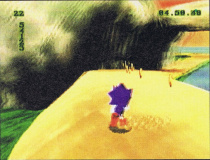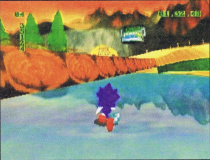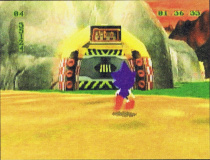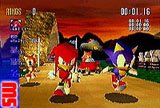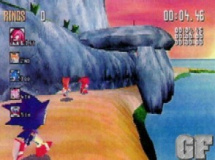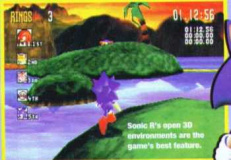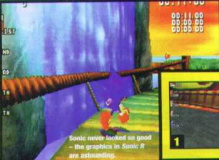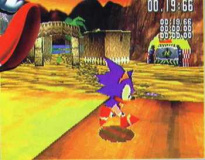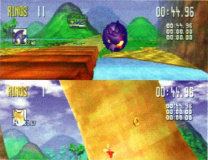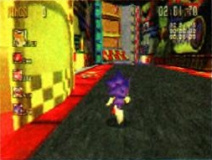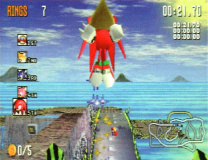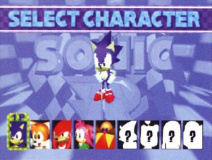Difference between revisions of "Sonic R/Development"
From Sonic Retro
(Better.) |
|||
| Line 1: | Line 1: | ||
''[[Sonic R]]'' had gone through several changes over its development process. There are several rejected ideas, level designs, and other things that were changed before the games final release. The following details several of these things. | ''[[Sonic R]]'' had gone through several changes over its development process. There are several rejected ideas, level designs, and other things that were changed before the games final release. The following details several of these things. | ||
| − | == | + | ==Development process== |
| − | + | ''Sonic R'' was the second ''Sonic the Hedgehog''-related project to be entrusted to [[Traveller's Tales]], a British studio previously responsible for ''[[Sonic 3D: Flickies' Island]]'' in 1996, and host of other projects prior. Many of the core members of the Traveller's Tales staff worked on both projects, including studio head [[Jon Burton]] (design and programming) and lead artist James Cunliffe. Similarly to ''Sonic 3D'', the project was overseen by members of [[Sonic Team]] - Sonic Team would outline the requirements and provide feedback, and Traveller's Tales would implement their demands. | |
| − | ==Prototype | + | ''Sonic R'' began its life as a Formula One game, still developed for Sega, but without the ''Sonic'' license. Traveller's Tales' "arch rivals" [[sega:Bizarre Creations|Bizarre Creations]] had released the extremely popular [[sega:PlayStation|PlayStation]] game ''Formula 1'' in 1996 (and would coincidentally be picked up to create the [[Sega Dreamcast]] game ''[[sega:Metropolis Street Racer|Metropolis Street Racer]]'' on the grounds of its success)), and Sega wanted a response from the studio, who got to work on this project shortly after. |
| − | This early box art was found on Compuserve internet servers back in 1998. The artwork here is found in the ending scene in the game. It | + | |
| + | The team spent a few months working on the Formula One project (writing an engine and even producing 3D assets) before the troubled ''[[Sonic X-treme]]'' was cancelled. This led to Sega cancelling the Formula One project in its original form, and tasking Traveller's Tales with adapting the engine into a ''Sonic'' racing game in time for Christmas 1997. | ||
| + | |||
| + | For a while, ''Sonic R'' was referred to as "''Sonic TT''", with the source code still making reference to that original title. This was not a nod to Traveller's Tales, but was to fit in with other racing terms such as "Time Trial" or "Tourist Trophy" (and ''[[Manx TT SuperBike]]'' released by Sega two years prior). | ||
| + | |||
| + | The game appeared at [[E3 1997]] in a playable form, however Jon Burton noticed that people were giving up when Sonic ran into the water, on account of his underwater speed being so slow. This was sped up in response. | ||
| + | |||
| + | A planned flame shield was removed from the game after it was considered to be too similar to the thunder shield in design. | ||
| + | |||
| + | ===Music=== | ||
| + | Similar to ''Sonic 3D'''s Saturn outing, the music of ''Sonic R'' was composed by [[Richard Jacques]], however this time vocals were added by [[T.J. Davis]]. Wary of vocals in a ''Sonic'' game being deemed strange, Jon Burton added a switch to use non-vocal tracks, before warming to the idea later in development. | ||
| + | |||
| + | Notably [[Resort Island]]'s theme, [[Can You Feel the Sunshine?]] caused the level to be changed to take place in a different time of day. In earlier builds the game takes place at sunset, as opposed to a time of day where you would be more likely to actually "feel the sunshine". | ||
| + | |||
| + | ==Prototype cover artwork== | ||
| + | This early box art was found on Compuserve internet servers back in 1998. The artwork here is found in the ending scene in the game, and appears in earlier prototype title screens. It was rejected as it gave away that [[Metal Sonic]] was a secret character in the game. | ||
<gallery heights="160px" > | <gallery heights="160px" > | ||
Revision as of 13:06, 19 August 2018
Sonic R had gone through several changes over its development process. There are several rejected ideas, level designs, and other things that were changed before the games final release. The following details several of these things.
Contents
Development process
Sonic R was the second Sonic the Hedgehog-related project to be entrusted to Traveller's Tales, a British studio previously responsible for Sonic 3D: Flickies' Island in 1996, and host of other projects prior. Many of the core members of the Traveller's Tales staff worked on both projects, including studio head Jon Burton (design and programming) and lead artist James Cunliffe. Similarly to Sonic 3D, the project was overseen by members of Sonic Team - Sonic Team would outline the requirements and provide feedback, and Traveller's Tales would implement their demands.
Sonic R began its life as a Formula One game, still developed for Sega, but without the Sonic license. Traveller's Tales' "arch rivals" Bizarre Creations had released the extremely popular PlayStation game Formula 1 in 1996 (and would coincidentally be picked up to create the Sega Dreamcast game Metropolis Street Racer on the grounds of its success)), and Sega wanted a response from the studio, who got to work on this project shortly after.
The team spent a few months working on the Formula One project (writing an engine and even producing 3D assets) before the troubled Sonic X-treme was cancelled. This led to Sega cancelling the Formula One project in its original form, and tasking Traveller's Tales with adapting the engine into a Sonic racing game in time for Christmas 1997.
For a while, Sonic R was referred to as "Sonic TT", with the source code still making reference to that original title. This was not a nod to Traveller's Tales, but was to fit in with other racing terms such as "Time Trial" or "Tourist Trophy" (and Manx TT SuperBike released by Sega two years prior).
The game appeared at E3 1997 in a playable form, however Jon Burton noticed that people were giving up when Sonic ran into the water, on account of his underwater speed being so slow. This was sped up in response.
A planned flame shield was removed from the game after it was considered to be too similar to the thunder shield in design.
Music
Similar to Sonic 3D's Saturn outing, the music of Sonic R was composed by Richard Jacques, however this time vocals were added by T.J. Davis. Wary of vocals in a Sonic game being deemed strange, Jon Burton added a switch to use non-vocal tracks, before warming to the idea later in development.
Notably Resort Island's theme, Can You Feel the Sunshine? caused the level to be changed to take place in a different time of day. In earlier builds the game takes place at sunset, as opposed to a time of day where you would be more likely to actually "feel the sunshine".
Prototype cover artwork
This early box art was found on Compuserve internet servers back in 1998. The artwork here is found in the ending scene in the game, and appears in earlier prototype title screens. It was rejected as it gave away that Metal Sonic was a secret character in the game.
Early Game Design
Version 0.1
A YouTube channel by the name of GameHut, which was created by Jon Burton of Traveller's Tales, had shown off the earliest version of Sonic R, dubbed Version 0.1. This tech demo has a first person perspective and shows off an unused level.
Version 0.3
Jon Burton also showed off a later version of the game which he called Version 0.3. This version has you play as Sonic without any running animations go around an early version of Resort Island.
Resort Island
As the first stage in the game, Resort Island saw the most coverage in the gaming press. Most notably for a large chunk of development time the stage took place at a different time of day - sunset, as opposed to what appears to be the middle of the day. In the PC version of the game the weather varies, sunset being an option for the stage, however in the Sega Saturn version all stages remain at a fixed time of day.
Radical City
- Sr YellowTrail.jpg
The trail after hitting a speed boost is yellow instead of a large array of colors.
Reactive Factory
Various
| Sonic R | |
|---|---|
|
Manuals |
show;hide
Books:
Music: Songs: "Super Sonic Racing" | "Can You Feel the Sunshine" | "Living in the City" | "Back in Time" | "Work it Out" | "Diamond in the Sky" | "Number One" |

